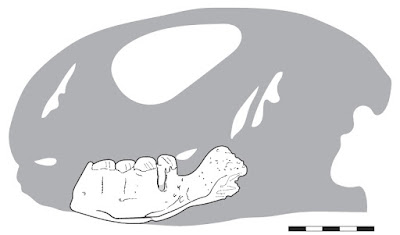Acrodontan
Lizards (Chameleons, Agamas, Iguanas and New World Lizards such as
Anoles) first appear in the fossil record in the Middle Jurassic of
India, and have spead to China, Myanmar and Brazil by the End of rhe
Cretaceous. They are a highly distinctive group, and have long been
thought, on the basis of morphological evidence, to be the earliest
group of Lizards to have branched off from the rest of the famiy,
though more recent molecular studies suggest that they are closely
related to Snakes and Anguimorph Lizards (Monitors etc.). Africa is
one of the modern biodiversity hotspots for this group, and is
thought likely to have hosted a major evolutionary radiation of them,
but to date there has been only a very limited number of fossil
Acrodontans discovered on the continent, including specimens from the
Palaeocene of Morocco, Algeria and Tunisia.
In a
paper published in the journal Royal Society Open Science on 21 September
2016, Sebastián Apesteguía of the Fundación de Historia Natural‘Félix de Azara’ at the Universidad Maimónides, Juan Daza of
the Department of Biological Sciences at Sam Houston StateUniversity, Tiago Simões of the Department of Biological Sciences at
the University of Alberta, and Jean Claude Rage of the MuséumNational d’Histoire Naturelle, describe a new
species of Agamid Lizard from the Late Cretaceous Kem Kem Beds of
northern Morocco.
The new
species is named Jeddaherdan aleadonta, where 'Jeddaherdan'
derives from the Amazigh Berber words for grandfather (Jeddi) and Spiny-tailed Lizard (Aherdan), and 'aleadonta' means
'dice-toothed' in reference to the roughly cubic shape of the teeth.
The species is described from a single fragment of dentary (lower
jaw) collected by the French palaeontologist René Lavocat
(1909–2007) from the Kem Kem Beds of Gara Tabroumit in southern
Morocco between 1948 and 1951 and stored in the collection of the
Muséum National d’Histoire Naturelle, where it was mistakenly
identified as the jaw of a Fish. Exact collection details for the
specimen are missing, but it is likely to be between 90 and 100.5
million years old.
Jeddaherdan
aleadonta (MNHN.F.MRS51.1) in (a) dorsal; (b) lateral; (c)medial;
(d) ventral views. Scale bar equals 5 mm. Abbreviations: An.ft, angular facet;A.pr, alveolar process; Co.ft, coronoid
facet; Co.pr, coronoid process;D.su, dentary sulcus; m.f, mental
foramen; Mk.g, Meckel’s groove; pv.pr, posteroventral process;
San.ft, surangular facet; sd.cr, sub-dental crest; sd.sh, sub-dental
shelf; si.cr, sinusoidal crest; tt.w, tooth wear; Part.ft,
prearticular facet. Apesteguía et al.
(2016).
Most
Lizards replace their teeth continuously throughout their lives,
however in Acrodontans this tooth replacement is very limited,
occurring only at the front of the jaw and only in growing juveniles.
The teeth at the side of the mouth are replaced serially during life,
with new teeth erupting behind (i.e. further back on the jaw) the old
as these are worn down. In the Moroccan Agamid specimen the teeth are
worn at the front of the jaw fragment, and there are no signs of
further eruptions at the back of the jaw, suggesting that this was an
individual appoaching the end of its natural life-span.
The
estimated silhouette of the skull of MNHN.F.MRS51.1 is based on
Uromastyx aegyptia (FMNH78661). Scale bar equals 5 mm.
Apesteguía et al. (2016).
See also...
 Anolis landestoyi: A Chameleon-Like Anole Lizard from Hispaniola. The Anole Lizards of the Greater Antilles islands are considered a
classic example of island biogeography. Easch Island has its own set of
Lizards, which tend to be most closely related...
Anolis landestoyi: A Chameleon-Like Anole Lizard from Hispaniola. The Anole Lizards of the Greater Antilles islands are considered a
classic example of island biogeography. Easch Island has its own set of
Lizards, which tend to be most closely related...  Tropidurus sertanejo: A new species of Ground Lizard from Bahia State, Brazil. Ground Lizards of the genus Tropidurus are found across tropical
and subtropical South America. They are ground dwelling Iguanas,
favouring open habitats, closely related to the Marine Iguanas...
Tropidurus sertanejo: A new species of Ground Lizard from Bahia State, Brazil. Ground Lizards of the genus Tropidurus are found across tropical
and subtropical South America. They are ground dwelling Iguanas,
favouring open habitats, closely related to the Marine Iguanas... Albanerpetontids, Frogs and Lizards from the Late Cretaceous of northeast Spain. During the Late
Cretaceous high sea levels split Europe up into a series of islands,
each with its...
Albanerpetontids, Frogs and Lizards from the Late Cretaceous of northeast Spain. During the Late
Cretaceous high sea levels split Europe up into a series of islands,
each with its...
Follow Sciency Thoughts on Facebook.


